TCPA proposes 13 steps to deliver truly affordable housing
By Daniel Fryd, Senior Consultant
Despite positive moves to get councils building, the planning system is failing to deliver affordable homes in the country’s poorest areas, a new TCPA report suggests.
The responsibility for building affordable homes is now firmly in councils’ courts following the Prime Minister’s move to lift the Housing Revenue account borrowing cap. Make no mistake – scrapping the borrowing cap is a huge move which means councils finally have the freedom they have been crying out for to significantly boost affordable housing supply.
According to a new research paper from the TCPA, however, the scale of the housing crisis is so severe that despite the new freedom for councils to build, the planning system will continue to fill the gap through requiring developers to build affordable housing within new developments.
With a woeful 2% of councils achieving their full affordable housing target through the planning system, there is clearly a long way to go and further changes needed before we see a genuine uplift in supply. Getting councils building is only one part of the solution.
Affording “affordable” homes
To unpick the problem with affordable housing you have to take a step back.
Speak to young people looking to get on the housing ladder about ‘affordable housing’ and you face the same questions: what does ‘affordable’ actually mean? Affordable to whom?
The fact the new NPPF now links affordable housing to market rates, especially in high value areas like London, simply means it in is line with the price of other homes which are broadly unaffordable for young people.
The TCPA report ‘Planning for Affordable Housing’, released just weeks before Budget 2018, draws on this as a key theme in the report, suggesting the definition of affordable homes should be amended in the NPPF to be based on a measure of local income instead of being pegged to an arbitrary proportion of market rates.
Linking provision of affordable homes to market rates, rather than local incomes, can lead to a situation where councils cannot set their own rents based on local incomes to ensure they meet local need.
13 steps to build affordable homes
Drawing on this, ‘Planning for Affordable Housing’ puts forward 13 recommendations to improve the planning system to deliver affordable housing, including an overarching recommendation for Government to set a target for the number of new affordable homes the country needs, and a strategy for how to achieve this figure.
Key recommendations include reform of viability assessments to ensure developers build affordable homes after planning approval, reform of land value capture to remove the ‘hope value’ of land and the rescinding of permitted development rights, which delivers no affordable.
None of these proposals are likely to prove popular with developers, however. The viability system is heavily relied on by developers building homes in expensive areas of high demand (i.e. the entire South East), in order to make their investment feasible.
Land value capture reform has proven unpopular in discussions held by the HCLG committee with developers and planners – Ian Fletcher, director of real estate policy at the British Property Federation (BPF), highlighted that “Crudely applied reform… will deter much-needed private sector investment into housing delivery and our town and city centres.”
The Letwin Review
The Letwin Review, published this week at the same time as the Autumn Budget, revealed quite bold plans for councils to compulsorily purchase land at a rate capped at “around ten times existing use value” in order to provide the affordable housing the market requires. This will be an interesting attempt to crack the nut of land value capture in a way which does not drive down land supply.
The removal of the HRA borrowing cap, as well as the announcements in this week’s Budget for an extra £650m for councils, and a further £500m of funding for the Housing Infrastructure Fund, to unlock 650,000 homes, will go some way to meeting the housing deficit.
Further measures and further planning changes are clearly still needed before we see a real uptick in provision, however.
Read more about the latest planning news:

Strategic land and site promotion
“Chelgate gives a real insight into political thinking at all levels and all political persuasions, …

Energy and infrastructure
From new nuclear and unconventional gas to renewables, waste and airports, our team has worked …


